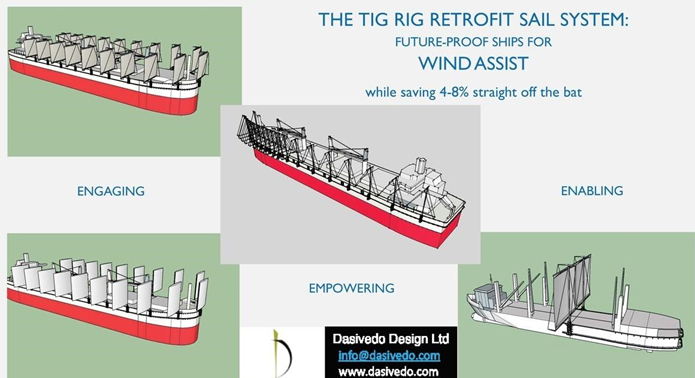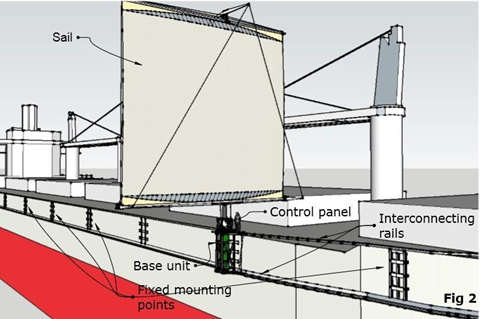Features
Update 2022/4/5
Wind
Saving our planet one ship at a time
Vancouver Start-Up Dasivedo Design moves forward with plans
to retrofit vessels with Wind Assist Technology
By Suzanne Forcese
“In terms of full life energy cycles, wind assist is hands down the most carbon-efficient of all the alternative power technologies for shipping.” --Alistair Johnson, Inventor of the Tig Rig Retrofit System and Founder of Dasivedo Design

With an internationally patent-protected design, the Tig Rig Retrofit Sail System offers a collaboratively disruptive, Poseidon Principles compliant standardized modular mounting system for all current and future masted wind assist devices which will help to reduce the use of fossil fuels and their carbon emissions. Drawings Courtesy Dasivedo Design
WATERTODAY spoke with Alistair Johnson, English-born Canadian inventor, member of the IWSA (International Windship Association)
Johnson’s design, The Tig Rig Retrofit Sail System is a means of retrofitting wind assist units (sails) to the world’s existing fleet of flat-decked merchant ships (tankers and bulkers) to help reduce their use of fossil fuels and their carbon emissions.
WT: What is the reason you are focusing on retrofit
Johnson: There are 40,000 flat decked ships in the world’s merchant fleet. With a 30-year life span, there is a replacement rate of 1,667 ships per annum.
If we had 100% zero-emissions ships, we could only build them at this rate.
If they cost the same as regular ships at $60M, then for a total of $100M per annum we’d see overall fleet carbon savings of 3.45% in the first year
Retrofitting @ $1.2M to each 40,000 flat decked ships will cost $48B and save 3.2% in fleet emissions. More with added solar/better wind assist devices. Wind delivers a bigger carbon bang for your buck with better full energy life cycle.
Tig Rigs are twice as carbon cost-effective as non-existent zero-emissions ships. The carbon bang for your buck should be where you start.
WT: You are an anthropologist. WT is curious to know what went “Boom” in the night to make you take a different tack in your career and life mission.
Johnson: The Planet Crisis is the defining challenge of our age. We must reduce or eliminate greenhouse gas emissions by radically reducing fossil fuel use. We have no choice and very little time.
Shipping carries 90% of world trade with emissions as high as the whole country of Germany.
It’s very much about the way language can inform thinking. The conversation these days is about alternative fuels. But that conversation ignores alternative power. Wind is an alternative power source. And it’s free.
For me, this shift in perception began over a dozen years ago while visiting a friend in England who worked for BP. He had a photograph in his hallway of an oil tanker making way under very heavy weather, and I thought... ‘What a waste of energy with all that wind’.
WT: From that shift, there would have been innumerable steps to get to the point where you now have a viable alternative to GHG emissions. Can you give our viewers some insights into those steps and the challenges that you overcame?
Johnson: I thought if this is going to be done, the system has to be put on the outside of ships. Hull mountings would be important.
It took about 10 years to complete the drawings. The last thing I worked out was the way the hull mountings would mount and the rail system which is critical.

The Tig Rig consists of self-contained sail units mounted at fixed mounting points round the outside of the hull of the ship. The mounting points are interconnected by rails that run around the stern of the ship. This allows the units to be wheeled around the ship clear of the dockside of the ship in port for regular dockside operations to proceed unrestricted. The mounting system can be used to mount other wind assist devices apart from the Tig Rig and so offers itself as a standardized mounting for current and future wind assist vessels. Drawing Courtesy Alistair Johnson designer of the Tig Rig Retrofit Sail System
It is actually very important because you’ve got the fixed mountings which are in place and they are interconnected by rails and you simply reel them around using very simple technology which is a rope, one loop per unit and a capstan and a couple of Velcro connectors and that’s it. Very simple.
WT: It almost seems too simple. No one else is doing this?
Johnson: I did professional patent searches and was astounded that no one was doing this, so I thought I better keep going.
WT: Is the shipping industry on board with wind assist?
Johnson: The IMO (International Maritime Organization) has recently granted consultancy status to the IWSA (International Windship Association) and this means that no major policy documents will be released that do not discuss wind as an alternate source of power as opposed to alternative fuel. This is how perception will be shifted.
WT: And is that paradigm shift occurring?
Johnson: Wind Assist is not in its infancy. It’s embryonic.
In 2018 I went to my first ever shipping conference at Shipping Insight in Connecticut. I was the only Wind Assist person there. No one knew anything about WA. I made a point about the technology for wind assist during a session and someone laughed. But at the end of the conference, I was awarded 2nd place in Design and the conference chair’s closing address began “Carbon is the elephant in the room”.
In 2019 I was again attending the conference as 1 in 3 wind assist people. Around a quarter of the conference centered around carbon. No one laughed.
In 2020, I attended the virtual conference, I learned that after a year of operation the Poseidon Principles have effectively meant finance proposals without emissions reductions components cannot get financed. Also, The Sea Cargo Charter now obliges charterers to select ships that deliver emissions reductions.
WT: It appears that you are the only company in Canada that is involved in WA. Is this a fact?
Johnson: The North American position is not as far up to speed as the European. There are two providers in the U.S. As far as Canada, I am not aware of anyone else.
We are assembling our team and have worked out a budget for going to trial. We are also very fortunate to have a ship designer in Vancouver whose designs are stunning.
WT: And investors?
Johnson: We are looking to attract angel investors.
It all comes down to changing the paradigm from alternative fuel to alternative power. The most important point is to defeat the whole carbon cycle. It’s very difficult to shout loudly about something that is against the herd, or too outside the box for mainstream thinking.
What the turning points are, no one can predict, but there must come a point when people accept that wind assist is the full carbon cycle best defence.
Only disruptive collaboration will liberate thinking and productivity. It can’t be done through existing structures. Because of my belief in disruptive collaboration, I am offering shares in my mounting system to every other designer and every shipping company.
The clock is ticking on the climate crisis and we don’t have time to go through regular channels.
|